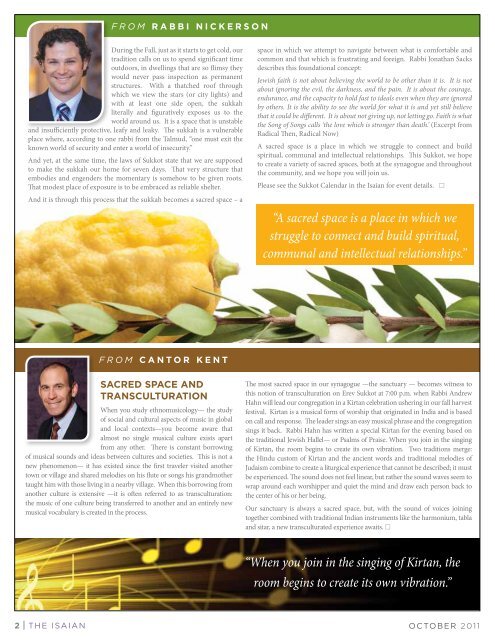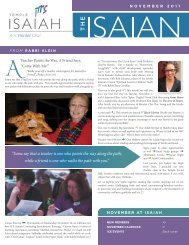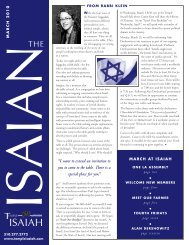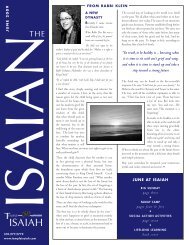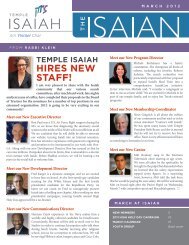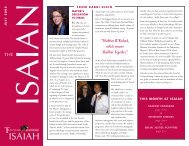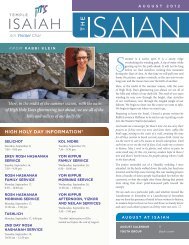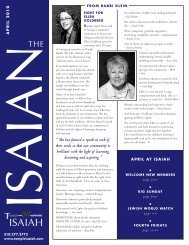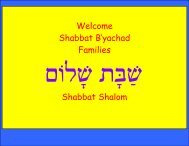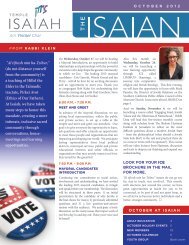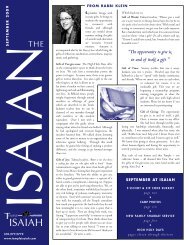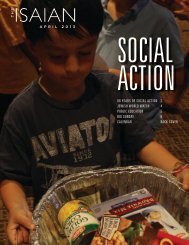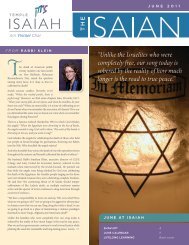Create successful ePaper yourself
Turn your PDF publications into a flip-book with our unique Google optimized e-Paper software.
FROM RABBI NICKERSON<br />
During the Fall, just as it starts to get cold, our<br />
tradition calls on us to spend significant time<br />
outdoors, in dwellings that are so flimsy they<br />
would never pass inspection as permanent<br />
structures. With a thatched roof through<br />
which we view the stars (or city lights) and<br />
with at least one side open, the sukkah<br />
literally and figuratively exposes us to the<br />
world around us. It is a space that is unstable<br />
and insufficiently protective, leafy and leaky. The sukkah is a vulnerable<br />
place where, according to one rabbi from the Talmud, “one must exit the<br />
known world of security and enter a world of insecurity.”<br />
And yet, at the same time, the laws of Sukkot state that we are supposed<br />
to make the sukkah our home for seven days. That very structure that<br />
embodies and engenders the momentary is somehow to be given roots.<br />
That modest place of exposure is to be embraced as reliable shelter.<br />
And it is through this process that the sukkah becomes a sacred space – a<br />
space in which we attempt to navigate between what is comfortable and<br />
common and that which is frustrating and foreign. Rabbi Jonathan Sacks<br />
describes this foundational concept:<br />
Jewish faith is not about believing the world to be other than it is. It is not<br />
about ignoring the evil, the darkness, and the pain. It is about the courage,<br />
endurance, and the capacity to hold fast to ideals even when they are ignored<br />
by others. It is the ability to see the world for what it is and yet still believe<br />
that it could be different. It is about not giving up, not letting go. Faith is what<br />
the Song of Songs calls ‘the love which is stronger than death.’ (Excerpt from<br />
Radical Then, Radical Now)<br />
A sacred space is a place in which we struggle to connect and build<br />
spiritual, communal and intellectual relationships. This Sukkot, we hope<br />
to create a variety of sacred spaces, both at the synagogue and throughout<br />
the community, and we hope you will join us.<br />
Please see the Sukkot Calendar in the Isaian for event details. <br />
“A sacred space is a place in which we<br />
struggle to connect and build spiritual,<br />
communal and intellectual relationships.”<br />
FROM CANTOR KENT<br />
Sacred Space and<br />
Transculturation<br />
When you study ethnomusicology— the study<br />
of social and cultural aspects of music in global<br />
and local contexts—you become aware that<br />
almost no single musical culture exists apart<br />
from any other. There is constant borrowing<br />
of musical sounds and ideas between cultures and societies. This is not a<br />
new phenomenon— it has existed since the first traveler visited another<br />
town or village and shared melodies on his flute or songs his grandmother<br />
taught him with those living in a nearby village. When this borrowing from<br />
another culture is extensive —it is often referred to as transculturation:<br />
the music of one culture being transferred to another and an entirely new<br />
musical vocabulary is created in the process.<br />
The most sacred space in our synagogue —the sanctuary — becomes witness to<br />
this notion of transculturation on Erev Sukkot at 7:00 p.m. when Rabbi Andrew<br />
Hahn will lead our congregation in a Kirtan celebration ushering in our fall harvest<br />
festival. Kirtan is a musical form of worship that originated in India and is based<br />
on call and response. The leader sings an easy musical phrase and the congregation<br />
sings it back. Rabbi Hahn has written a special Kirtan for the evening based on<br />
the traditional Jewish Hallel— or Psalms of Praise. When you join in the singing<br />
of Kirtan, the room begins to create its own vibration. Two traditions merge:<br />
the Hindu custom of Kirtan and the ancient words and traditional melodies of<br />
Judaism combine to create a liturgical experience that cannot be described; it must<br />
be experienced. The sound does not feel linear, but rather the sound waves seem to<br />
wrap around each worshipper and quiet the mind and draw each person back to<br />
the center of his or her being.<br />
Our sanctuary is always a sacred space, but, with the sound of voices joining<br />
together combined with traditional Indian instruments like the harmonium, tabla<br />
and sitar, a new transculturated experience awaits. <br />
“When you join in the singing of Kirtan, the<br />
room begins to create its own vibration.”<br />
2 | THE ISAIAN<br />
October 2011


